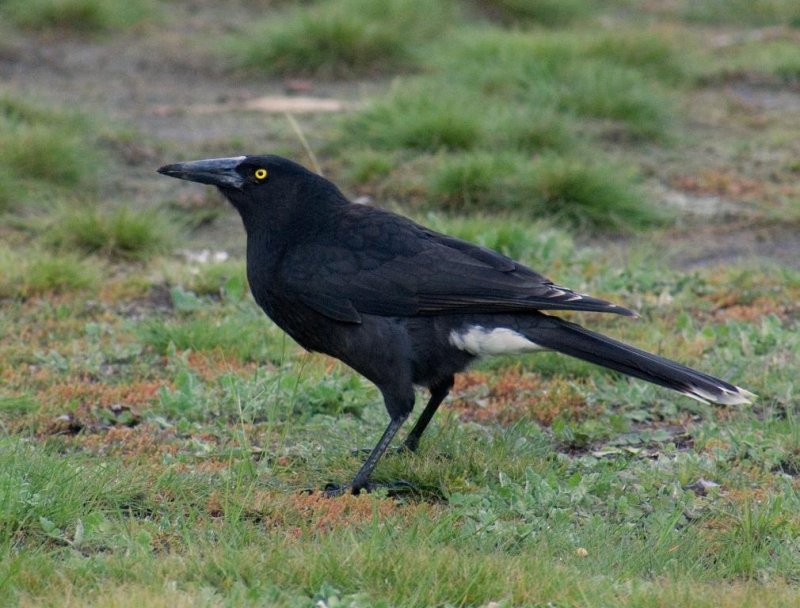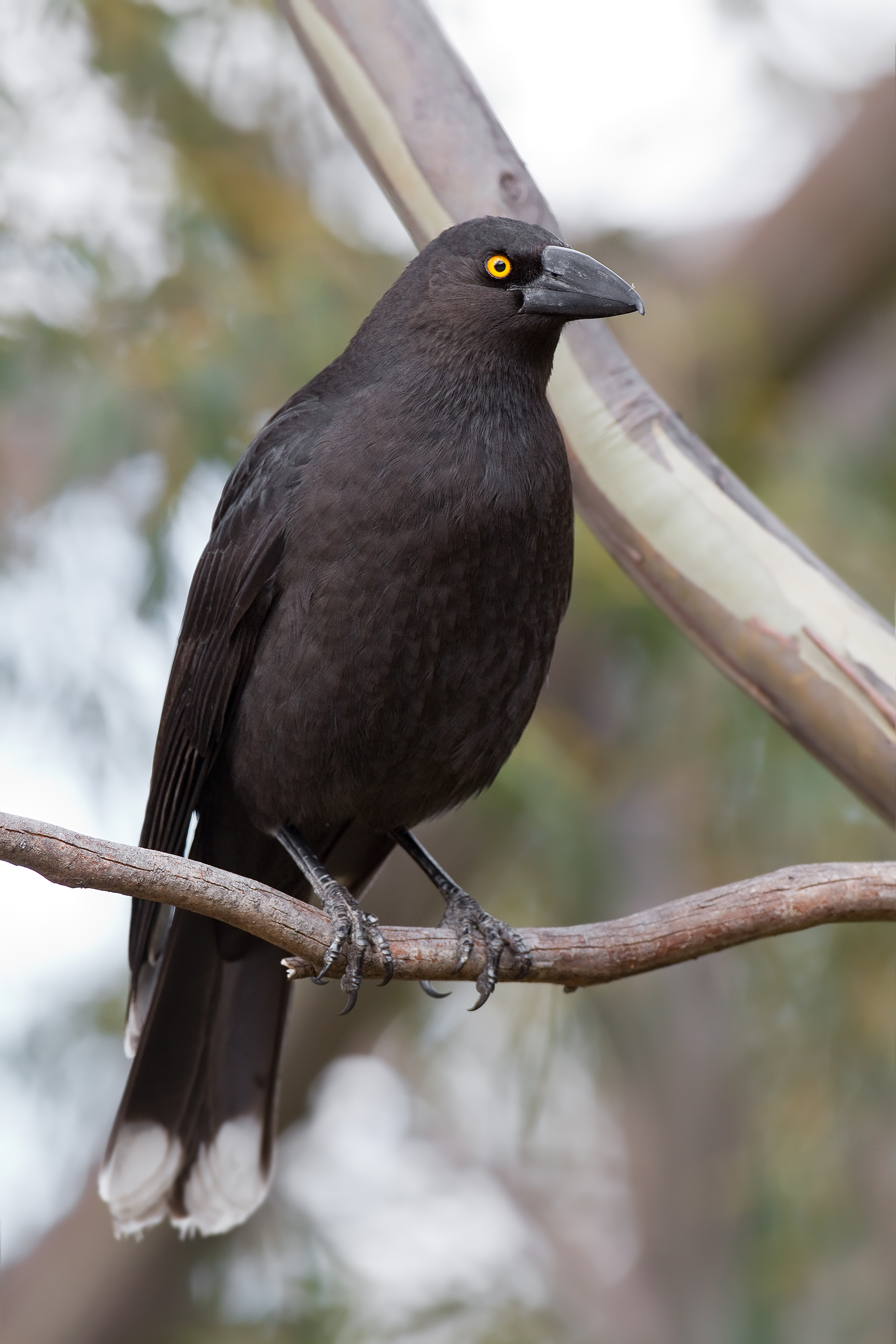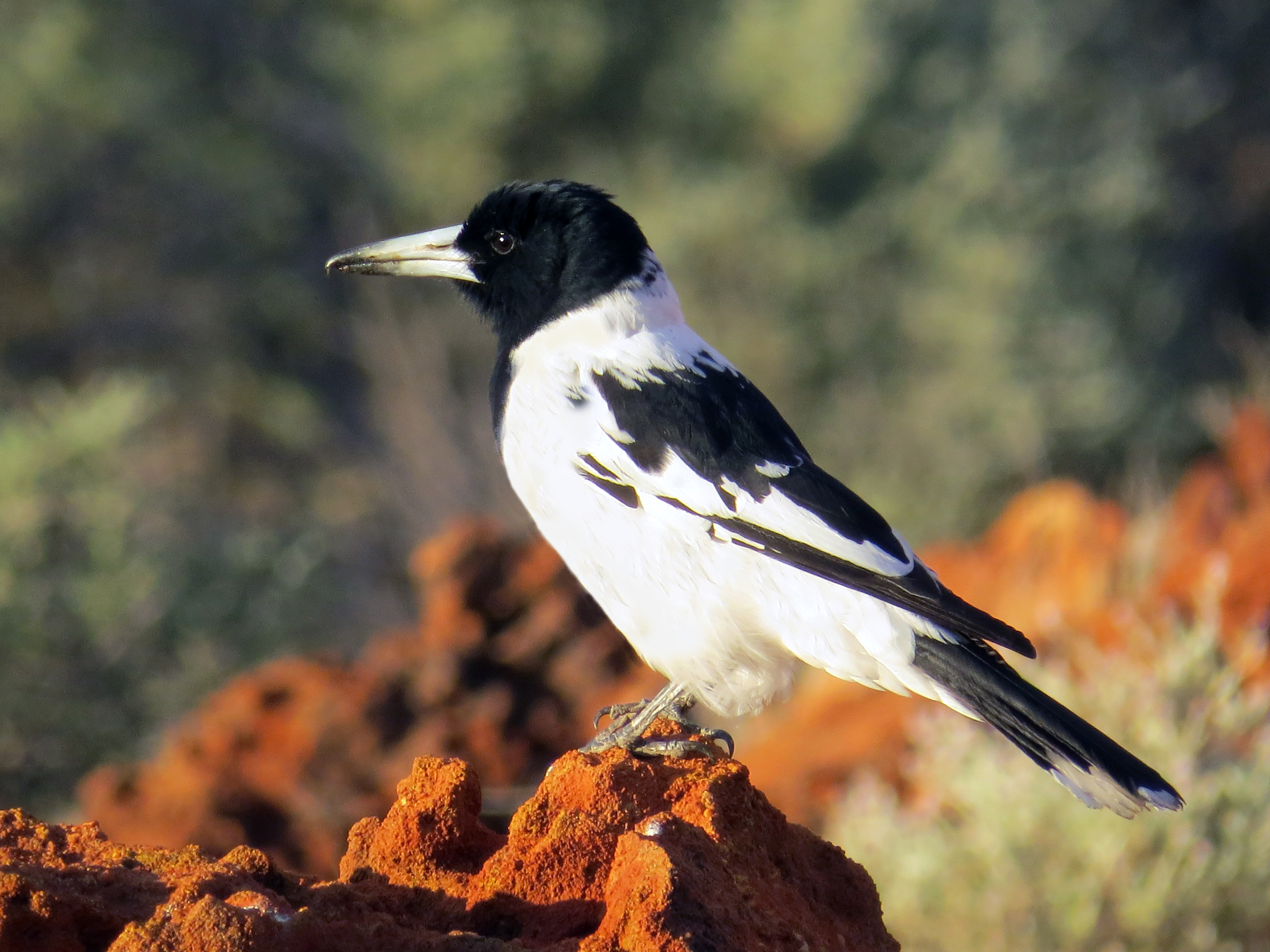|
Cracticidae
The Cracticinae, bellmagpies and allies, gathers together 12 species of mostly crow-like birds native to Australasia and nearby areas. Historically, the cracticines – currawongs, Australian magpie and butcherbirds – were seen as a separate family Cracticidae and, according to the 2018 Cements List, they still are. With their 1985 DNA study, Sibley and Ahlquist recognised the close relationship between the woodswallows and the butcherbirds in 1985, and placed them in a Cracticini clade, now the family Artamidae. The two species of peltops were once placed with the monarch flycatchers but are now placed here. The cracticines have large, straight bills and mostly black, white or grey plumage. All are omnivorous to some degree: the butcherbirds mostly eat meat; Australian magpies usually forage through short grass looking for worms and other small creatures; and currawongs are true omnivores, taking fruit, grain, meat, insects, eggs and nestlings. The female constructs bulky n ... [...More Info...] [...Related Items...] OR: [Wikipedia] [Google] [Baidu] |
Artamidae
Artamidae is a family of passerine birds found in Australia, the Indo-Pacific region, and Southern Asia. It includes 24 extant species in six genera and three subfamilies: Peltopsinae (with one genus, ''Peltops''), Artaminae (with one genus containing the woodswallows) and Cracticinae (currawongs, butcherbirds and the Australian magpie). Artamids used to be monotypic, containing only the woodswallows, but it was expanded to include the family Cracticidae in 1994. Some authors, however, still treat the two as separate families. Some species in this family are known for their beautiful song. Their feeding habits vary from nectar sucking (woodswallows) to predation on small birds (pied currawong). Taxonomy and systematics The family Artamidae was introduced by the Irish zoologist Nicholas Aylward Vigors in 1825. The artamids are part of the superfamily Malaconotoidea, a lineage which is widespread through Australasia and consists of a vast diversity of omnivorous and carnivorous ... [...More Info...] [...Related Items...] OR: [Wikipedia] [Google] [Baidu] |
Grey Currawong
The grey currawong (''Strepera versicolor'') is a large passerine bird native to southern Australia, including Tasmania. One of three currawong species in the genus ''Strepera'', it is closely related to the butcherbirds and Australian magpie of the family Artamidae. It is a large crow-like bird, around long on average; with yellow irises, a heavy bill, dark plumage with white undertail and wing patches. The male and female are similar in appearance. Six subspecies are recognised and are distinguished by overall plumage colour, which ranges from slate-grey for the nominate from New South Wales and eastern Victoria and subspecies ''plumbea'' from Western Australia, to sooty black for the clinking currawong of Tasmania and subspecies ''halmaturina'' from Kangaroo Island. All grey currawongs have a loud distinctive ringing or clinking call. Within its range, the grey currawong is generally sedentary, although it is a winter visitor in the southeastern corner of Australia. Comparati ... [...More Info...] [...Related Items...] OR: [Wikipedia] [Google] [Baidu] |
Black Currawong
The black currawong (''Strepera fuliginosa''), also known locally as the black jay, is a large passerine bird endemic to Tasmania and the nearby islands within the Bass Strait. One of three currawong species in the genus ''Strepera'', it is closely related to the butcherbirds and Australian magpie within the family Artamidae. It is a large crow-like bird, around long on average, with yellow irises, a heavy bill, and black plumage with white wing patches. The male and female are similar in appearance. Three subspecies are recognised, one of which, ''Strepera fuliginosa colei'' of King Island, is vulnerable to extinction. Within its range, the black currawong is generally sedentary, although populations at higher altitudes relocate to lower areas during the cooler months. The habitat includes densely forested areas as well as alpine heathland. It is rare below altitudes of . Omnivorous, its diet includes a variety of berries, invertebrates, and small vertebrates. Less arboreal t ... [...More Info...] [...Related Items...] OR: [Wikipedia] [Google] [Baidu] |
Strepera
Currawongs are three species of medium-sized passerine birds belonging to the genus ''Strepera'' in the family Artamidae native to Australia. These are the grey currawong (''Strepera versicolor''), pied currawong (''S. graculina''), and black currawong (''S. fuliginosa''). The common name comes from the call of the familiar pied currawong of eastern Australia and is onomatopoeic. They were formerly known as crow-shrikes or bell-magpies. Despite their resemblance to crows and ravens, they are only distantly related to the corvidae, instead belonging to an Afro-Asian radiation of birds of superfamily Malaconotoidea. They are not as terrestrial as the magpie and have shorter legs. They are omnivorous, foraging in foliage, on tree trunks and limbs, and on the ground, taking insects and larvae (often dug out from under the bark of trees), fruit, and the nestlings of other birds. They are distinguishable from magpies and crows by their comical flight style in amongst foliage, appearing ... [...More Info...] [...Related Items...] OR: [Wikipedia] [Google] [Baidu] |
Strepera Fuliginosa 4
Currawongs are three species of medium-sized passerine birds belonging to the genus ''Strepera'' in the family Artamidae native to Australia. These are the grey currawong (''Strepera versicolor''), pied currawong (''S. graculina''), and black currawong (''S. fuliginosa''). The common name comes from the call of the familiar pied currawong of eastern Australia and is onomatopoeic. They were formerly known as crow-shrikes or bell-magpies. Despite their resemblance to crows and ravens, they are only distantly related to the corvidae, instead belonging to an Afro-Asian radiation of birds of superfamily Malaconotoidea. They are not as terrestrial as the magpie and have shorter legs. They are omnivorous, foraging in foliage, on tree trunks and limbs, and on the ground, taking insects and larvae (often dug out from under the bark of trees), fruit, and the nestlings of other birds. They are distinguishable from magpies and crows by their comical flight style in amongst foliage, appea ... [...More Info...] [...Related Items...] OR: [Wikipedia] [Google] [Baidu] |
Peltops
''Peltops'' is a genus of birds in the family Artamidae. It contains two species that are endemic to the island of New Guinea. The species have also had the common name of shieldbill. Taxonomy The genus ''Peltops'' was introduced by the German zoologist Johann Georg Wagler in 1829. The type species is the lowland peltops. The name is from the Greek ''pelte'' meaning small shield and ''ops'' meaning face. The genus was once placed with the monarch flycatchers, but molecular and morphometric studies place it closer to the butcherbirds, possibly as a sister taxon to this group. The genus is placed in its own subfamily, Peltopsinae. The genus contains two species: Description ''Peltops'' are smaller than the butcherbirds, and have a less massive but still large bill. The mountain peltops is the larger species, at , whereas the lowland peltops is slightly smaller at . The hooked bill is the same size in both species, making it proportionally larger in the lowland peltops. Distrib ... [...More Info...] [...Related Items...] OR: [Wikipedia] [Google] [Baidu] |
Pied Butcherbird
The pied butcherbird (''Cracticus nigrogularis'') is a songbird native to Australia. Described by John Gould in 1837, it is a black and white bird long with a long hooked bill. Its head and throat are black, making a distinctive hood; the mantle and much of the tail and wings are also black. The neck, underparts and outer wing feathers are white. The juvenile and immature birds are predominantly brown and white. As they mature their brown feathers are replaced by black feathers. There are two recognised subspecies of pied butcherbird. Within its range, the pied butcherbird is generally sedentary. Common in woodlands and in urban environments, it is carnivorous, eating insects and small vertebrates including birds. A tame and inquisitive bird, the pied butcherbird has been known to accept food from humans. It nests in trees, constructing a cup-shaped structure out of sticks and laying two to five eggs. The pied butcherbird engages in cooperative breeding, with a mated pair some ... [...More Info...] [...Related Items...] OR: [Wikipedia] [Google] [Baidu] |
Peltops
''Peltops'' is a genus of birds in the family Artamidae. It contains two species that are endemic to the island of New Guinea. The species have also had the common name of shieldbill. Taxonomy The genus ''Peltops'' was introduced by the German zoologist Johann Georg Wagler in 1829. The type species is the lowland peltops. The name is from the Greek ''pelte'' meaning small shield and ''ops'' meaning face. The genus was once placed with the monarch flycatchers, but molecular and morphometric studies place it closer to the butcherbirds, possibly as a sister taxon to this group. The genus is placed in its own subfamily, Peltopsinae. The genus contains two species: Description ''Peltops'' are smaller than the butcherbirds, and have a less massive but still large bill. The mountain peltops is the larger species, at , whereas the lowland peltops is slightly smaller at . The hooked bill is the same size in both species, making it proportionally larger in the lowland peltops. Distrib ... [...More Info...] [...Related Items...] OR: [Wikipedia] [Google] [Baidu] |
Pied Butcherbird
The pied butcherbird (''Cracticus nigrogularis'') is a songbird native to Australia. Described by John Gould in 1837, it is a black and white bird long with a long hooked bill. Its head and throat are black, making a distinctive hood; the mantle and much of the tail and wings are also black. The neck, underparts and outer wing feathers are white. The juvenile and immature birds are predominantly brown and white. As they mature their brown feathers are replaced by black feathers. There are two recognised subspecies of pied butcherbird. Within its range, the pied butcherbird is generally sedentary. Common in woodlands and in urban environments, it is carnivorous, eating insects and small vertebrates including birds. A tame and inquisitive bird, the pied butcherbird has been known to accept food from humans. It nests in trees, constructing a cup-shaped structure out of sticks and laying two to five eggs. The pied butcherbird engages in cooperative breeding, with a mated pair some ... [...More Info...] [...Related Items...] OR: [Wikipedia] [Google] [Baidu] |
Australian Magpie
The Australian magpie (''Gymnorhina tibicen'') is a black and white passerine bird native to Australia and southern New Guinea. Although once considered to be three separate species, it is now considered to be one, with nine recognised subspecies. A member of the Artamidae, the Australian magpie is placed in its own genus ''Gymnorhina'' and is most closely related to the black butcherbird (''Melloria quoyi''). It is not closely related to the European magpie, which is a corvid. The adult Australian magpie is a fairly robust bird ranging from in length, with black and white plumage, gold brown eyes and a solid wedge-shaped bluish-white and black bill. The male and female are similar in appearance, but can be distinguished by differences in back markings. The male has pure white feathers on the back of the head and the female has white blending to grey feathers on the back of the head. With its long legs, the Australian magpie walks rather than waddles or hops and spends mu ... [...More Info...] [...Related Items...] OR: [Wikipedia] [Google] [Baidu] |
Currawong
Currawongs are three species of medium-sized passerine birds belonging to the genus ''Strepera'' in the family Artamidae native to Australia. These are the grey currawong (''Strepera versicolor''), pied currawong (''S. graculina''), and black currawong (''S. fuliginosa''). The common name comes from the call of the familiar pied currawong of eastern Australia and is onomatopoeic. They were formerly known as crow-shrikes or bell-magpies. Despite their resemblance to crows and ravens, they are only distantly related to the corvidae, instead belonging to an Afro-Asian radiation of birds of superfamily Malaconotoidea. They are not as terrestrial as the magpie and have shorter legs. They are omnivorous, foraging in foliage, on tree trunks and limbs, and on the ground, taking insects and larvae (often dug out from under the bark of trees), fruit, and the nestlings of other birds. They are distinguishable from magpies and crows by their comical flight style in amongst foliage, appearing ... [...More Info...] [...Related Items...] OR: [Wikipedia] [Google] [Baidu] |
Pied Currawong
The pied currawong (''Strepera graculina'') is a black passerine bird native to eastern Australia and Lord Howe Island. One of three currawong species in the genus ''Strepera'', it is closely related to the butcherbirds and Australian magpie of the family Artamidae. Six subspecies are recognised. It is a robust crowlike bird averaging around in length, black or sooty grey-black in plumage with white undertail and wing patches, yellow irises, and a heavy bill. The male and female are similar in appearance. Known for its melodious calls, the species' name ''currawong'' is believed to be of indigenous origin. Within its range, the pied currawong is generally sedentary, although populations at higher altitudes relocate to lower areas during the cooler months. It is omnivorous, with a diet that includes a wide variety of berries and seeds, invertebrates, bird eggs, juvenile birds and young marsupials. It is a predator which has adapted well to urbanization and can be found in parks ... [...More Info...] [...Related Items...] OR: [Wikipedia] [Google] [Baidu] |







